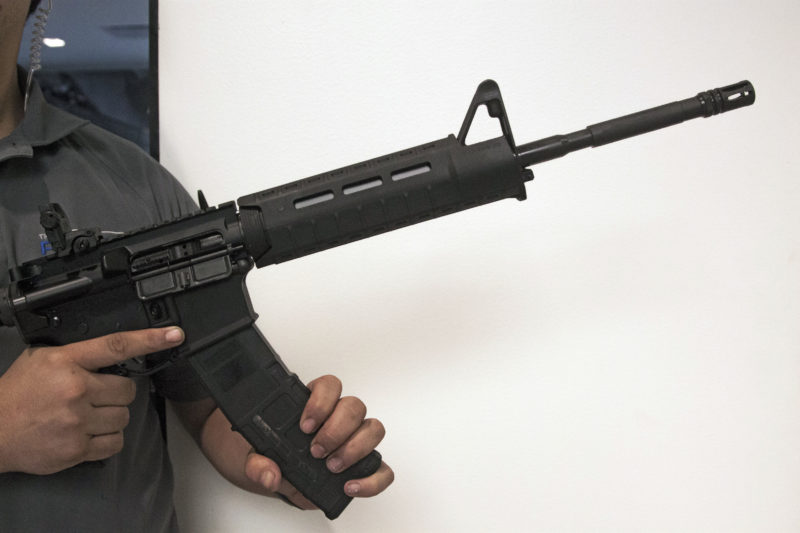Austin Company’s Rifle Magazines Will Go Into the Field With Marines
By Zach Caldwell
Reporting Texas

An employee of The Range, an Austin shooting facility, inserts a Magpul magazine into a civilian variant of the military’s M-4 carbine. Ignatius Koh/Reporting Texas
When infantry solders report for duty, a supply sergeant hands them a stack of rifle magazines.
Soldiers must carry at least seven of the ammunition holders, which are often hand-me-downs. They train to swap them quickly to stay loaded. In time, soldiers learn to guide their hands, without looking or thinking, to the most accessible magazine, the “happy mag.”
Military-issue magazines, usually made of aluminum, are finicky. The springs that push cartridges into the firing chamber weaken when magazines are left loaded. The top part, called “feed lips,” warps and cracks with abuse. Sand, grime and rust accumulate. Magazine breakdowns are among the most common reasons for a weapon to stop working. Many troops spend their own money on improved, commercially made replacements like those made by Austin-based Magpul Industries Corp.
In December, the Marine Corps announced that Magpul’s third-generation “PMag” would be the only magazines in the rifles of Marines deployed in combat. The plastic mechanisms will feed the Marines’ standard-issue M-4 carbine, the M-16 rifle and the newly fielded M-27 infantry automatic rifle.
Jake Enfield, a 27-year-old Marine veteran studying exercise science at the University of Texas at Austin, used Magpul’s magazines in Afghanistan as part of a field trial. He says he was impressed with their durability and ease of use, particularly while wearing gloves. Marines, he says, often purchased PMags with their own cash well before they were officially authorized.
“The Magpul ones, I thought, were much better most of the time,” Enfield said in an interview. “I thought they lasted better and that goes hand-in-hand with reliability.”
Magpul is a bifurcated company, with headquarters in Austin and a factory in Cheyenne, Wyoming. Originally based in Erie, Colorado, Magpul left in 2015 after that state banned the sale of magazines holding more than 15 rounds of ammunition. PMags can hold up to 30 rounds.
Duane Liptak, executive vice president at Magpul, said in an email exchange that the company chose Austin for its administrative center because of the city’s talent pool. The company chose Cheyenne as its manufacturing location because it is close to the company’s former Colorado location and fits the company’s established delivery network.
“We wanted to be able to maximize our ability to put the right people in the right seats,” Liptak said.
Magpul will soon be expanding operations as it becomes the Marines’ primary magazine supplier. Neither Magpul nor the Marines would say how much the contract is worth. There are about 182,000 Marines, and PMags sell for a retail price of around $17. At seven magazines per soldier, the contract means well over 1 million magazines.
The PMag is a departure from the standard-issue magazine that has been in place, with minor tweaks, since the Vietnam War. Instead of aluminum, the PMag is made of a rugged polymer. It has a transparent window that lets soldiers see how many rounds are left.
“For years, service men and women from all branches have used their own money to make sure they had PMags in their rifles to give them the best performance possible,” Liptak said. “The Marine Corps had finally had enough, and had the wisdom to buck the system.”
Barbara Hamby, a Marine Corps spokeswoman, says the search for better magazines began in 2015 and pitted the PMag against other commercially produced magazines.
“It was one of a few that performed acceptably with the Army’s enhanced-performance round,” Hamby said in a phone interview, referring to the “green ammo” introduced in 2010 to enhance both lethality and environmental friendliness. The cartridge replaces slugs made of lead, a serious pollutant, with copper and steel.
Liptak says the increased military demand shouldn’t affect availability in stores. The PMag is a hot seller in gun stores, says Jorge Sandoval, sales associate at The Range in South Austin.
“In the civilian market, they are more popular [than aluminum magazines], especially because you can get them in different colors,” Sandoval said in an interview. He says the polymer magazines are easier to maintain and don’t rust.
NATO, whose 28 nations stretch from Turkey to Canada, mandates magazine compatibility across its armies. Several member states, including the U.K., have already adopted the PMag, and recent political pressure for member countries to increase military spending may be a boon to Magpul in coming years.
“We certainly hope so, for multiple reasons,” Liptak said. In anticipation of the new business from the Marine Corps contract, the Austin operation will be filling new positions in marketing, product management and design, he says.
Liptak declined to say how many employees the company has or how much revenue it generates. A Dun & Bradstreet report on Magpul from 2015 indicated annual revenue of more than $27 million, and more than 100 employees.
“The final numbers will depend on the capabilities of the candidates that we find,” Liptak said.
Enfield sees the change as good news. In his rifle company, it was common for Marines to use Magpul’s magazines even before they were authorized for use. His superiors, he says, took a pragmatic view of the privately purchased magazines.
“As long as your s- -t worked, it wasn’t causing any issue,” Enfield said.
Zach Caldwell is a former Army infantryman.